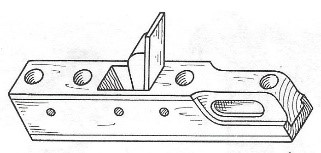The development of hand tools for woodworking
Stone origin
Tools made of stone, which can be called the archetype of the axe and saw, originated in the Mesolithic period (8000 to 4500 BC). These first special woodworking tools will have been used initially to make firewood, hunting and defensive weapons, or to roughly dress the wood as building material for shelters.
The first stone saw-like tools that man made for himself were very simple in design. They appeared as straight or bow-shaped pieces of flint, toothed on one or two sides and hardly more than 20 cm long.
As early as 6000 years ago, Stone Age man succeeded in drilling a hole in hard stone to make a shaft hole for an axe. Not yet in possession of metal, a technique of abrasive drilling was used. The first drilling tools were exceedingly simple. A piece of wood, possibly with a tip of flint, or a tubular bone, but also a tubular piece of horn – moved between the hands held flat – was all that was available to man for this hard work.
Only the use of the fiddle drill (bow drill), which could also be used for making fire, made the work easier. With its simple technique, it was used in the Bronze and Iron Ages until the late Middle Ages. It is still in use today in the Middle East, India and Africa.
Working with an arch drill Relief in Sakara around 2400 BC.
Metal tools
The first working tools that man made of metal were tools made of copper. The advantage of copper was that it was easier to work with than the stones used until then for tools and weapons. The real and enormous progress in the use of metal as a raw material for working tools occurred when man learned, more than 6000 years ago, to melt and cast the metal.
About a thousand years later, the observation that an addition of tin gave copper better properties led to the invention of the first artificial alloy, bronze, and its use in toolmaking. Only tools cast from tin bronze had utility properties that made the metal tool superior to the stone tool.
Thus, after the axe, chisel and drill and other woodworking tools, the first metal saws were made almost 5000 years ago, initially from copper, later from bronze. The oldest preserved metal saw is a copper saw of Egyptian origin, around 2700 B.C. The setting of saws was not yet known. To prevent the tiresome „jamming“ of the saw, the blade was cast so that the cross-section tapered from the tooth line to the back of the blade.
Among the woodworking tools, the axe, the small crosscut axe, which was particularly suitable for smoothing raw surfaces or for making curved parts, gained increasing importance in the Bronze Age. The plane was not yet known. The axe, which originated in the Stone Age, was preferably used in shipbuilding, in the production of furniture or cooperage products.
The shape and dimensions of the saws were probably similar to today’s hand saws as early as the 6th century BC. Chr. have corresponded to the today’s hand saws. Greek blacksmiths probably built the first saws with taut blades. Hacksaws date back to ancient Greece.
At the beginning of our calendar, the Romans still invented one of the last important tools for woodworking, the plane.
Roman plane with iron sole
Middle Ages
In the advanced Middle Ages, many of the skills and achievements temporarily lost with the decline and fall of the Roman Empire can be found again in Central Europe, including temporarily forgotten tools and processing techniques. From then on, carpenters, joiners and other woodworkers again used saws and planes instead of simple splitting and cutting tools to make their products.
The historically oldest hand saw, the tenon saw, which is still widely used today, was further developed into numerous special forms in the course of the later Middle Ages.
Emperor Maximilian I (1459 to 1519) with a grist saw in his hand among carpenters. Maximilian learned the carpenter’s trade from scratch in his youth. (Woodcut by H. Burkmair, c. 1515).
In 1515, Emperor Maximilian I elevated Riedau to the status of a market town.
Source: Historische Bilder und Texte VEB Fachbuchverlag Leipzig „Vom Steinbeil zum Sägegatter“ Finsterbusch/Thiele




